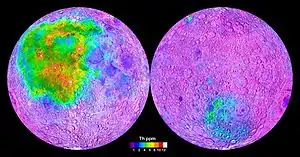Lunar terrane
The Moon is composed of two major geologic provinces that have a unique origin, composition, and thermal evolution. The Procellarum KREEP Terrane is a large province on the near side of the Moon that has high abundances of KREEP. KREEP, an acronym built from the letters K (the atomic symbol for potassium), REE (rare-earth elements) and P (for phosphorus), is a geochemical component of some lunar impact breccia and basaltic rocks. The Felspathic Highlands Terrane, in contrast is composed predominantly of ancient anorthositic materials. A third terrane, the South Pole–Aitken Terrane, may simply represent deep crustal materials of the feldspathic highlands terrane.

Thorium concentrations on the Moon. The large area of high concentration on the Near Side (left) corresponds to the Procellarum KREEP Terrane, and the smaller area on the Far Side (right) to the South Pole–Aitken Terrane. The large purple area to the north of this includes the Felspathic Highlands Terrane, which is not reflected in thorium concentrations.
References
- Jolliff, Bradley; Gillis, Jeffrey; Haskin, Larry; Korotev, Randy & Wieczorek, Mark (2000). "Major lunar crustal terranes" (PDF). J. Geophys. Res.: 4197–4216. Bibcode:2000JGR...105.4197J. doi:10.1029/1999je001103.
- Taylor, G. Jeffrey (31 August 2000). "A new Moon for the twenty-first century". Planetary Science Research Discoveries.
- Starr, Michelle (23 June 2020). "The Moon is lopsided, and new research could finally explain why". ScienceAlert. Retrieved 24 June 2020.
- Elardo, Stephen M.; Laneuville, Matthieu; McCubbin, Francis M.; Shearer, Charles K. (2020). "Early crust building enhanced on the Moon's nearside by mantle melting-point depression". Nature Geoscience. 13 (5): 339–343. doi:10.1038/s41561-020-0559-4. ISSN 1752-0894. S2CID 214704396.
This article is issued from Wikipedia. The text is licensed under Creative Commons - Attribution - Sharealike. Additional terms may apply for the media files.